Assessment for BSBHRM512: Performance Management Processes
VerifiedAdded on 2021/02/20
|48
|10005
|201
Homework Assignment
AI Summary
This document serves as a comprehensive assessment guide for the BSBHRM512 unit, focusing on developing and managing performance management processes. It details the elements of competency, including developing integrated performance-management processes, facilitating implementation, and coordinating learning and development. The assessment includes performance evidence, foundation skills, and knowledge evidence requirements. It outlines various assessment tools such as learner workbook activities, observation checklists, major activities, skills and knowledge activities, third-party checklists, and case studies. The document provides clear explanations of each tool, along with assessment conditions and links to companion volumes. Furthermore, the assessment emphasizes practical demonstrations and observations, requiring learners to showcase their ability to analyze organizational plans, design performance indicators, and manage performance effectively. The document also provides detailed observation checklists to ensure comprehensive assessment of the learner's skills and knowledge.
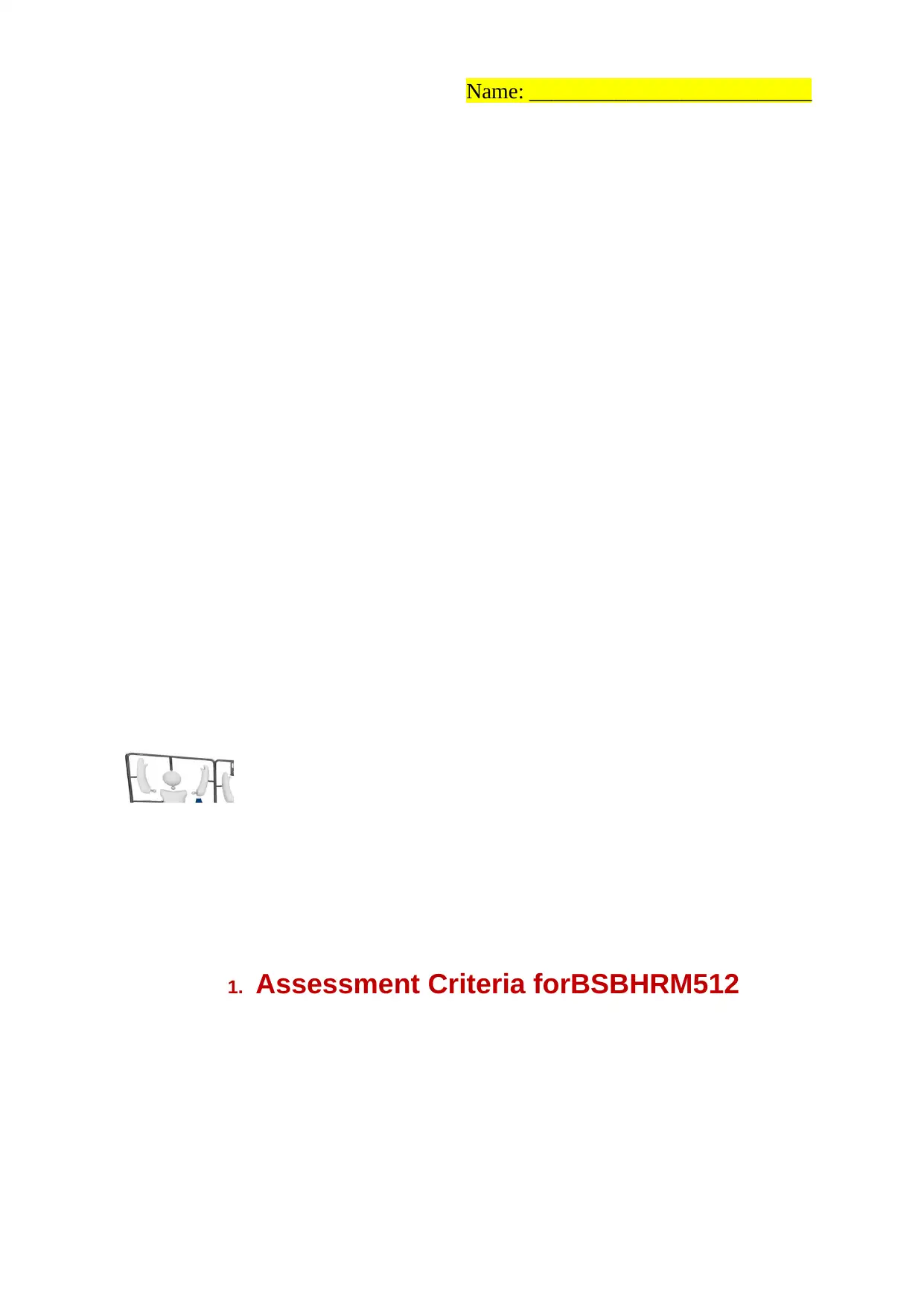
Name: __________________________
1. Assessment Criteria forBSBHRM512
1. Assessment Criteria forBSBHRM512
Paraphrase This Document
Need a fresh take? Get an instant paraphrase of this document with our AI Paraphraser
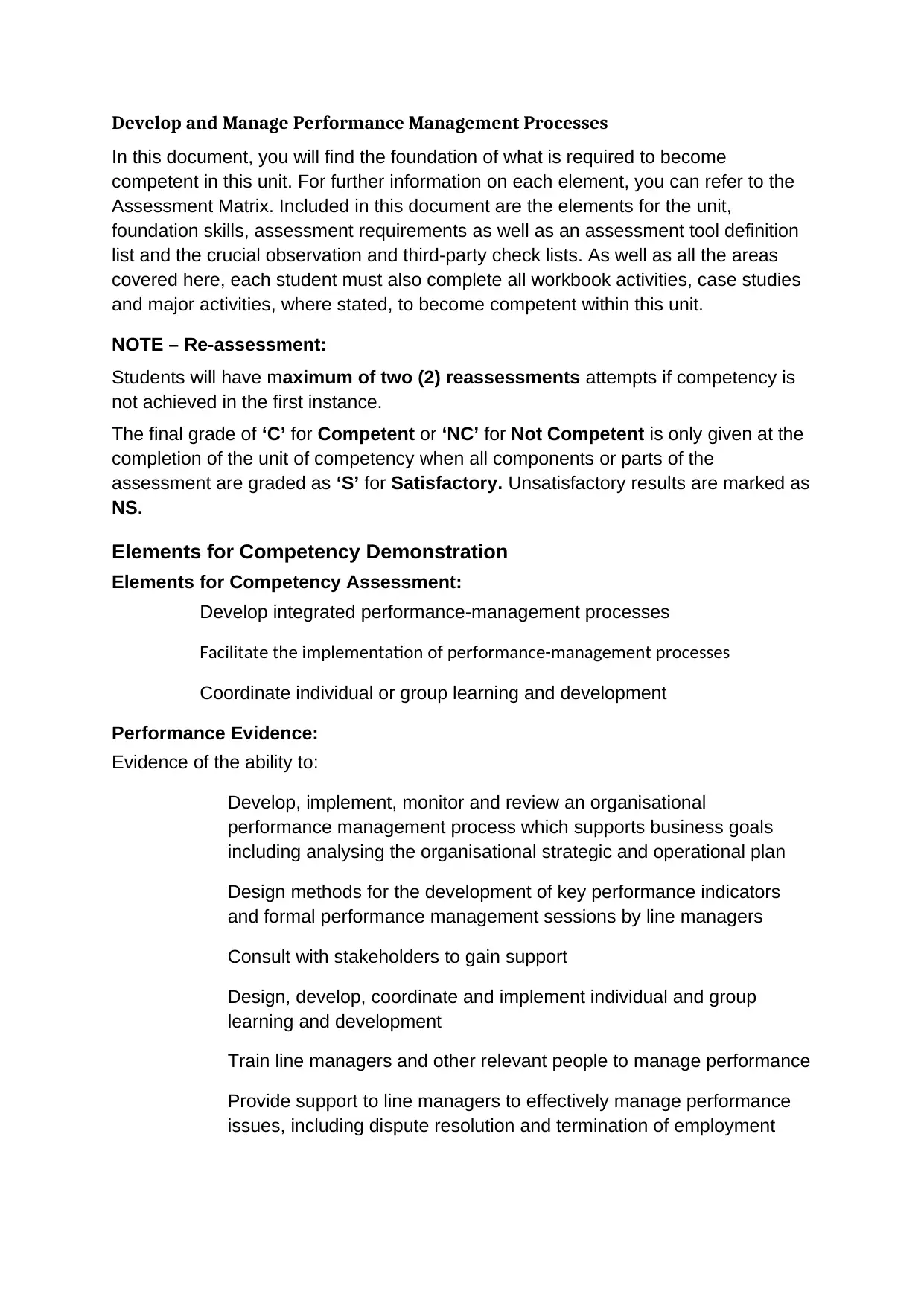
Develop and Manage Performance Management Processes
In this document, you will find the foundation of what is required to become
competent in this unit. For further information on each element, you can refer to the
Assessment Matrix. Included in this document are the elements for the unit,
foundation skills, assessment requirements as well as an assessment tool definition
list and the crucial observation and third-party check lists. As well as all the areas
covered here, each student must also complete all workbook activities, case studies
and major activities, where stated, to become competent within this unit.
NOTE – Re-assessment:
Students will have maximum of two (2) reassessments attempts if competency is
not achieved in the first instance.
The final grade of ‘C’ for Competent or ‘NC’ for Not Competent is only given at the
completion of the unit of competency when all components or parts of the
assessment are graded as ‘S’ for Satisfactory. Unsatisfactory results are marked as
NS.
Elements for Competency Demonstration
Elements for Competency Assessment:
Develop integrated performance-management processes
Facilitate the implementation of performance-management processes
Coordinate individual or group learning and development
Performance Evidence:
Evidence of the ability to:
Develop, implement, monitor and review an organisational
performance management process which supports business goals
including analysing the organisational strategic and operational plan
Design methods for the development of key performance indicators
and formal performance management sessions by line managers
Consult with stakeholders to gain support
Design, develop, coordinate and implement individual and group
learning and development
Train line managers and other relevant people to manage performance
Provide support to line managers to effectively manage performance
issues, including dispute resolution and termination of employment
In this document, you will find the foundation of what is required to become
competent in this unit. For further information on each element, you can refer to the
Assessment Matrix. Included in this document are the elements for the unit,
foundation skills, assessment requirements as well as an assessment tool definition
list and the crucial observation and third-party check lists. As well as all the areas
covered here, each student must also complete all workbook activities, case studies
and major activities, where stated, to become competent within this unit.
NOTE – Re-assessment:
Students will have maximum of two (2) reassessments attempts if competency is
not achieved in the first instance.
The final grade of ‘C’ for Competent or ‘NC’ for Not Competent is only given at the
completion of the unit of competency when all components or parts of the
assessment are graded as ‘S’ for Satisfactory. Unsatisfactory results are marked as
NS.
Elements for Competency Demonstration
Elements for Competency Assessment:
Develop integrated performance-management processes
Facilitate the implementation of performance-management processes
Coordinate individual or group learning and development
Performance Evidence:
Evidence of the ability to:
Develop, implement, monitor and review an organisational
performance management process which supports business goals
including analysing the organisational strategic and operational plan
Design methods for the development of key performance indicators
and formal performance management sessions by line managers
Consult with stakeholders to gain support
Design, develop, coordinate and implement individual and group
learning and development
Train line managers and other relevant people to manage performance
Provide support to line managers to effectively manage performance
issues, including dispute resolution and termination of employment
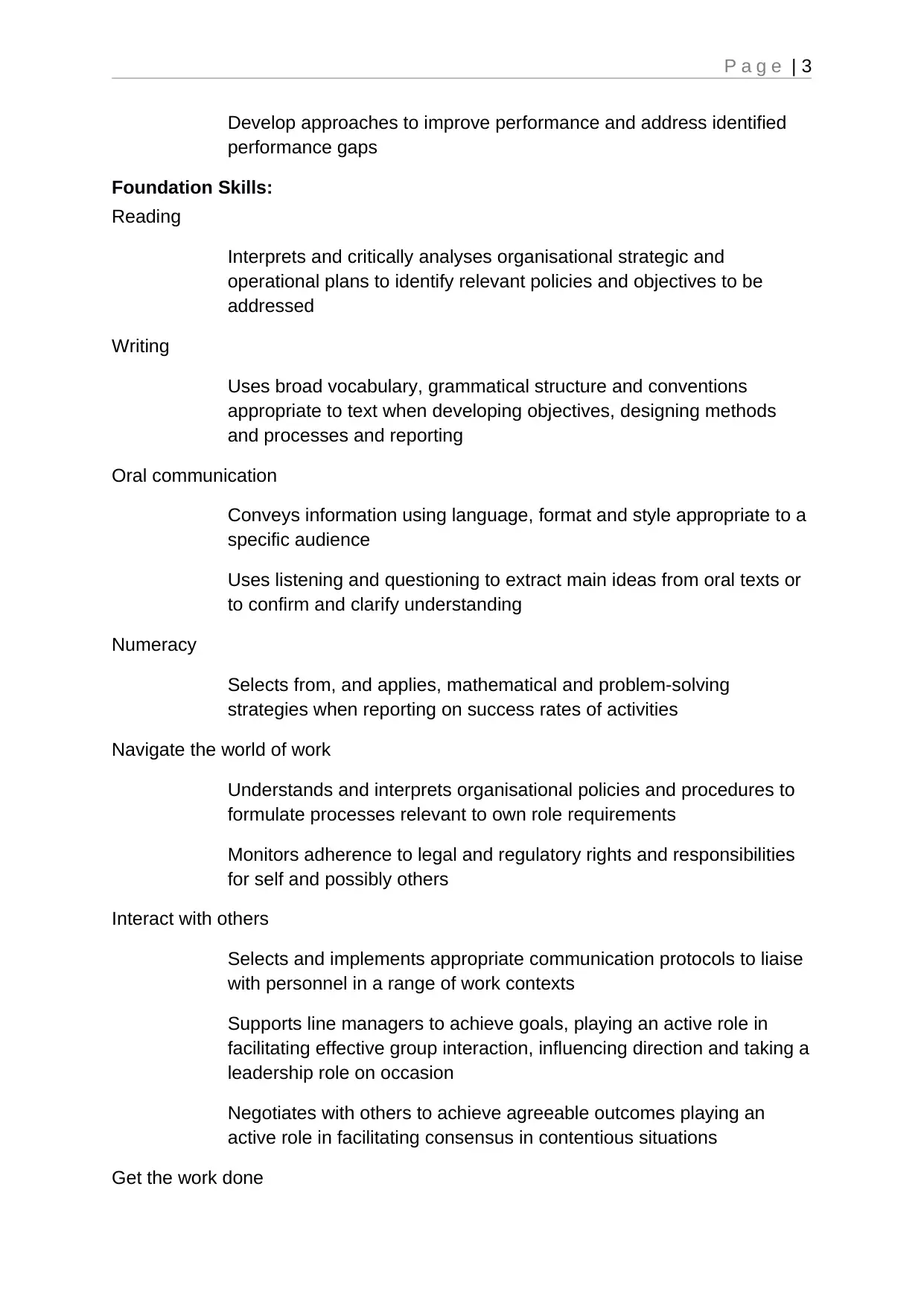
P a g e | 3
Develop approaches to improve performance and address identified
performance gaps
Foundation Skills:
Reading
Interprets and critically analyses organisational strategic and
operational plans to identify relevant policies and objectives to be
addressed
Writing
Uses broad vocabulary, grammatical structure and conventions
appropriate to text when developing objectives, designing methods
and processes and reporting
Oral communication
Conveys information using language, format and style appropriate to a
specific audience
Uses listening and questioning to extract main ideas from oral texts or
to confirm and clarify understanding
Numeracy
Selects from, and applies, mathematical and problem-solving
strategies when reporting on success rates of activities
Navigate the world of work
Understands and interprets organisational policies and procedures to
formulate processes relevant to own role requirements
Monitors adherence to legal and regulatory rights and responsibilities
for self and possibly others
Interact with others
Selects and implements appropriate communication protocols to liaise
with personnel in a range of work contexts
Supports line managers to achieve goals, playing an active role in
facilitating effective group interaction, influencing direction and taking a
leadership role on occasion
Negotiates with others to achieve agreeable outcomes playing an
active role in facilitating consensus in contentious situations
Get the work done
Develop approaches to improve performance and address identified
performance gaps
Foundation Skills:
Reading
Interprets and critically analyses organisational strategic and
operational plans to identify relevant policies and objectives to be
addressed
Writing
Uses broad vocabulary, grammatical structure and conventions
appropriate to text when developing objectives, designing methods
and processes and reporting
Oral communication
Conveys information using language, format and style appropriate to a
specific audience
Uses listening and questioning to extract main ideas from oral texts or
to confirm and clarify understanding
Numeracy
Selects from, and applies, mathematical and problem-solving
strategies when reporting on success rates of activities
Navigate the world of work
Understands and interprets organisational policies and procedures to
formulate processes relevant to own role requirements
Monitors adherence to legal and regulatory rights and responsibilities
for self and possibly others
Interact with others
Selects and implements appropriate communication protocols to liaise
with personnel in a range of work contexts
Supports line managers to achieve goals, playing an active role in
facilitating effective group interaction, influencing direction and taking a
leadership role on occasion
Negotiates with others to achieve agreeable outcomes playing an
active role in facilitating consensus in contentious situations
Get the work done
⊘ This is a preview!⊘
Do you want full access?
Subscribe today to unlock all pages.

Trusted by 1+ million students worldwide
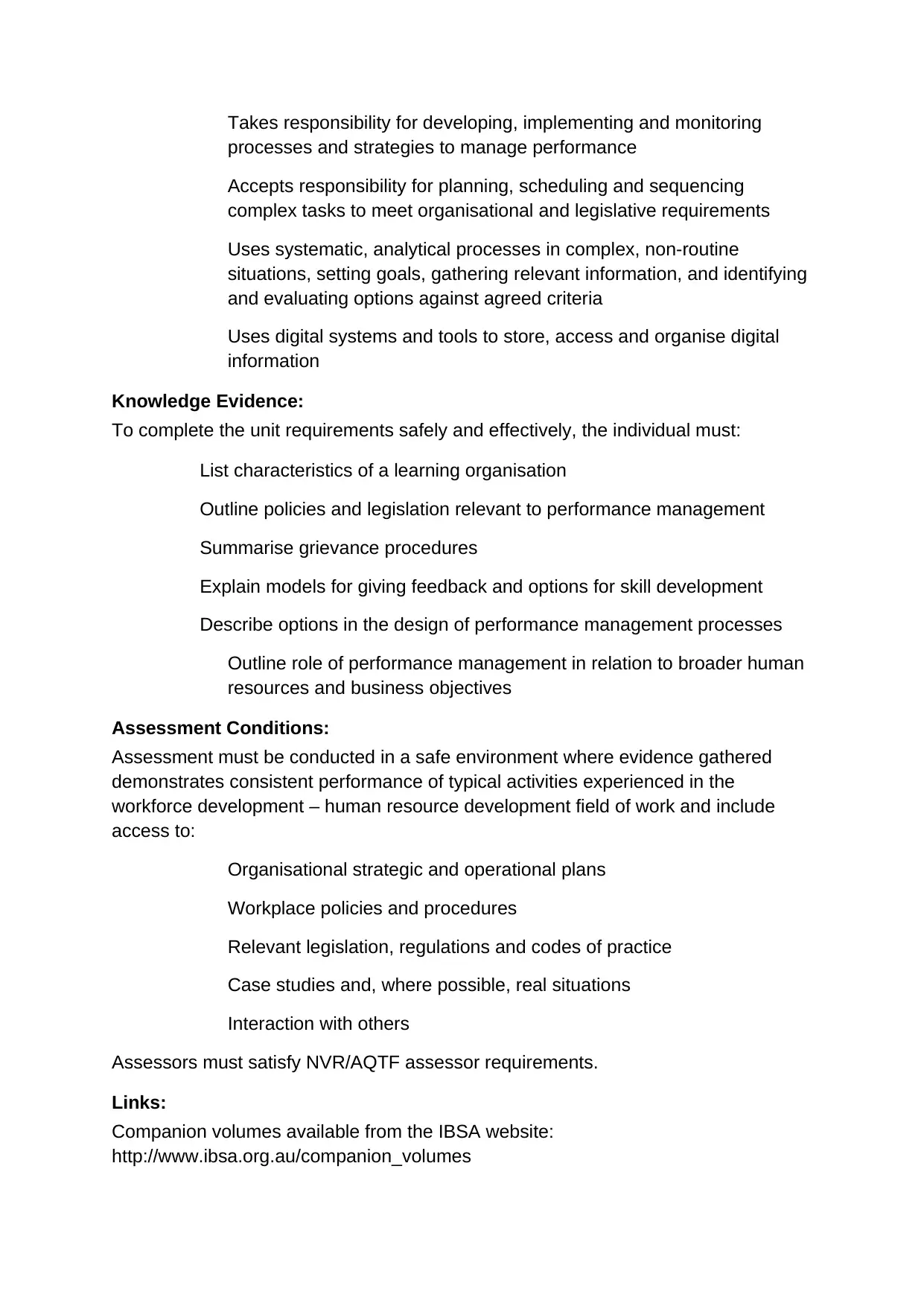
Takes responsibility for developing, implementing and monitoring
processes and strategies to manage performance
Accepts responsibility for planning, scheduling and sequencing
complex tasks to meet organisational and legislative requirements
Uses systematic, analytical processes in complex, non-routine
situations, setting goals, gathering relevant information, and identifying
and evaluating options against agreed criteria
Uses digital systems and tools to store, access and organise digital
information
Knowledge Evidence:
To complete the unit requirements safely and effectively, the individual must:
List characteristics of a learning organisation
Outline policies and legislation relevant to performance management
Summarise grievance procedures
Explain models for giving feedback and options for skill development
Describe options in the design of performance management processes
Outline role of performance management in relation to broader human
resources and business objectives
Assessment Conditions:
Assessment must be conducted in a safe environment where evidence gathered
demonstrates consistent performance of typical activities experienced in the
workforce development – human resource development field of work and include
access to:
Organisational strategic and operational plans
Workplace policies and procedures
Relevant legislation, regulations and codes of practice
Case studies and, where possible, real situations
Interaction with others
Assessors must satisfy NVR/AQTF assessor requirements.
Links:
Companion volumes available from the IBSA website:
http://www.ibsa.org.au/companion_volumes
processes and strategies to manage performance
Accepts responsibility for planning, scheduling and sequencing
complex tasks to meet organisational and legislative requirements
Uses systematic, analytical processes in complex, non-routine
situations, setting goals, gathering relevant information, and identifying
and evaluating options against agreed criteria
Uses digital systems and tools to store, access and organise digital
information
Knowledge Evidence:
To complete the unit requirements safely and effectively, the individual must:
List characteristics of a learning organisation
Outline policies and legislation relevant to performance management
Summarise grievance procedures
Explain models for giving feedback and options for skill development
Describe options in the design of performance management processes
Outline role of performance management in relation to broader human
resources and business objectives
Assessment Conditions:
Assessment must be conducted in a safe environment where evidence gathered
demonstrates consistent performance of typical activities experienced in the
workforce development – human resource development field of work and include
access to:
Organisational strategic and operational plans
Workplace policies and procedures
Relevant legislation, regulations and codes of practice
Case studies and, where possible, real situations
Interaction with others
Assessors must satisfy NVR/AQTF assessor requirements.
Links:
Companion volumes available from the IBSA website:
http://www.ibsa.org.au/companion_volumes
Paraphrase This Document
Need a fresh take? Get an instant paraphrase of this document with our AI Paraphraser
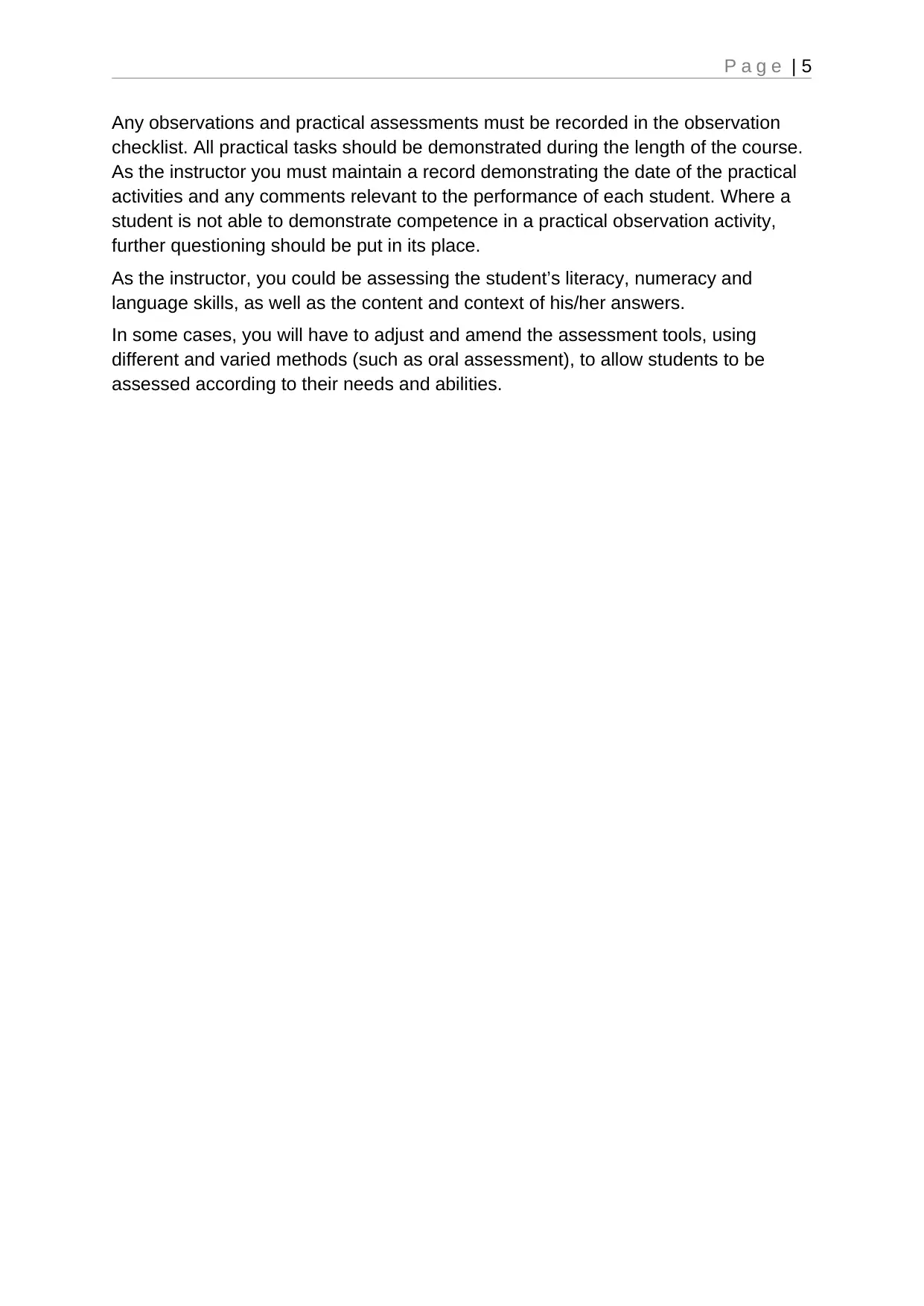
P a g e | 5
Any observations and practical assessments must be recorded in the observation
checklist. All practical tasks should be demonstrated during the length of the course.
As the instructor you must maintain a record demonstrating the date of the practical
activities and any comments relevant to the performance of each student. Where a
student is not able to demonstrate competence in a practical observation activity,
further questioning should be put in its place.
As the instructor, you could be assessing the student’s literacy, numeracy and
language skills, as well as the content and context of his/her answers.
In some cases, you will have to adjust and amend the assessment tools, using
different and varied methods (such as oral assessment), to allow students to be
assessed according to their needs and abilities.
Any observations and practical assessments must be recorded in the observation
checklist. All practical tasks should be demonstrated during the length of the course.
As the instructor you must maintain a record demonstrating the date of the practical
activities and any comments relevant to the performance of each student. Where a
student is not able to demonstrate competence in a practical observation activity,
further questioning should be put in its place.
As the instructor, you could be assessing the student’s literacy, numeracy and
language skills, as well as the content and context of his/her answers.
In some cases, you will have to adjust and amend the assessment tools, using
different and varied methods (such as oral assessment), to allow students to be
assessed according to their needs and abilities.
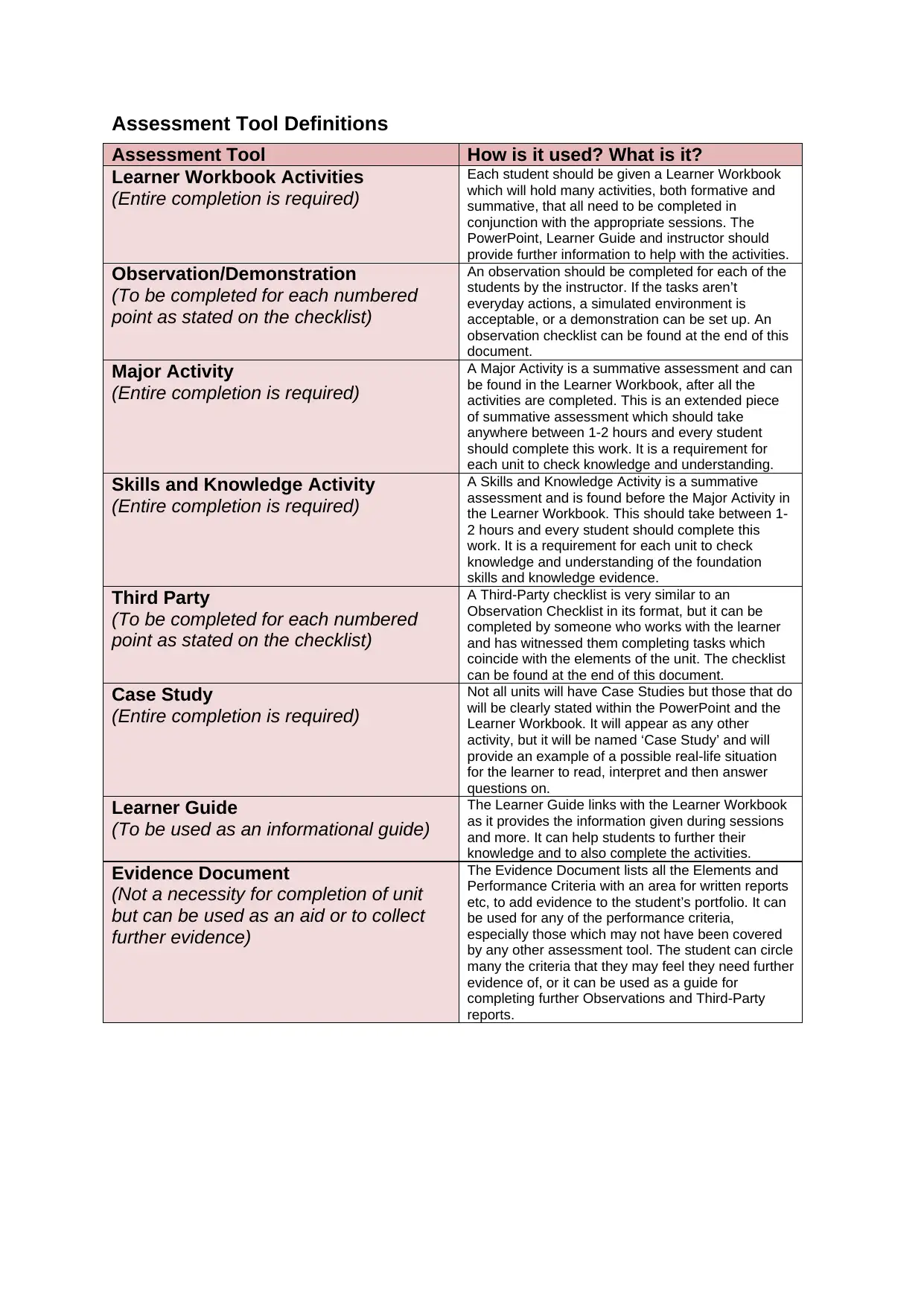
Assessment Tool Definitions
Assessment Tool How is it used? What is it?
Learner Workbook Activities
(Entire completion is required)
Each student should be given a Learner Workbook
which will hold many activities, both formative and
summative, that all need to be completed in
conjunction with the appropriate sessions. The
PowerPoint, Learner Guide and instructor should
provide further information to help with the activities.
Observation/Demonstration
(To be completed for each numbered
point as stated on the checklist)
An observation should be completed for each of the
students by the instructor. If the tasks aren’t
everyday actions, a simulated environment is
acceptable, or a demonstration can be set up. An
observation checklist can be found at the end of this
document.
Major Activity
(Entire completion is required)
A Major Activity is a summative assessment and can
be found in the Learner Workbook, after all the
activities are completed. This is an extended piece
of summative assessment which should take
anywhere between 1-2 hours and every student
should complete this work. It is a requirement for
each unit to check knowledge and understanding.
Skills and Knowledge Activity
(Entire completion is required)
A Skills and Knowledge Activity is a summative
assessment and is found before the Major Activity in
the Learner Workbook. This should take between 1-
2 hours and every student should complete this
work. It is a requirement for each unit to check
knowledge and understanding of the foundation
skills and knowledge evidence.
Third Party
(To be completed for each numbered
point as stated on the checklist)
A Third-Party checklist is very similar to an
Observation Checklist in its format, but it can be
completed by someone who works with the learner
and has witnessed them completing tasks which
coincide with the elements of the unit. The checklist
can be found at the end of this document.
Case Study
(Entire completion is required)
Not all units will have Case Studies but those that do
will be clearly stated within the PowerPoint and the
Learner Workbook. It will appear as any other
activity, but it will be named ‘Case Study’ and will
provide an example of a possible real-life situation
for the learner to read, interpret and then answer
questions on.
Learner Guide
(To be used as an informational guide)
The Learner Guide links with the Learner Workbook
as it provides the information given during sessions
and more. It can help students to further their
knowledge and to also complete the activities.
Evidence Document
(Not a necessity for completion of unit
but can be used as an aid or to collect
further evidence)
The Evidence Document lists all the Elements and
Performance Criteria with an area for written reports
etc, to add evidence to the student’s portfolio. It can
be used for any of the performance criteria,
especially those which may not have been covered
by any other assessment tool. The student can circle
many the criteria that they may feel they need further
evidence of, or it can be used as a guide for
completing further Observations and Third-Party
reports.
Assessment Tool How is it used? What is it?
Learner Workbook Activities
(Entire completion is required)
Each student should be given a Learner Workbook
which will hold many activities, both formative and
summative, that all need to be completed in
conjunction with the appropriate sessions. The
PowerPoint, Learner Guide and instructor should
provide further information to help with the activities.
Observation/Demonstration
(To be completed for each numbered
point as stated on the checklist)
An observation should be completed for each of the
students by the instructor. If the tasks aren’t
everyday actions, a simulated environment is
acceptable, or a demonstration can be set up. An
observation checklist can be found at the end of this
document.
Major Activity
(Entire completion is required)
A Major Activity is a summative assessment and can
be found in the Learner Workbook, after all the
activities are completed. This is an extended piece
of summative assessment which should take
anywhere between 1-2 hours and every student
should complete this work. It is a requirement for
each unit to check knowledge and understanding.
Skills and Knowledge Activity
(Entire completion is required)
A Skills and Knowledge Activity is a summative
assessment and is found before the Major Activity in
the Learner Workbook. This should take between 1-
2 hours and every student should complete this
work. It is a requirement for each unit to check
knowledge and understanding of the foundation
skills and knowledge evidence.
Third Party
(To be completed for each numbered
point as stated on the checklist)
A Third-Party checklist is very similar to an
Observation Checklist in its format, but it can be
completed by someone who works with the learner
and has witnessed them completing tasks which
coincide with the elements of the unit. The checklist
can be found at the end of this document.
Case Study
(Entire completion is required)
Not all units will have Case Studies but those that do
will be clearly stated within the PowerPoint and the
Learner Workbook. It will appear as any other
activity, but it will be named ‘Case Study’ and will
provide an example of a possible real-life situation
for the learner to read, interpret and then answer
questions on.
Learner Guide
(To be used as an informational guide)
The Learner Guide links with the Learner Workbook
as it provides the information given during sessions
and more. It can help students to further their
knowledge and to also complete the activities.
Evidence Document
(Not a necessity for completion of unit
but can be used as an aid or to collect
further evidence)
The Evidence Document lists all the Elements and
Performance Criteria with an area for written reports
etc, to add evidence to the student’s portfolio. It can
be used for any of the performance criteria,
especially those which may not have been covered
by any other assessment tool. The student can circle
many the criteria that they may feel they need further
evidence of, or it can be used as a guide for
completing further Observations and Third-Party
reports.
⊘ This is a preview!⊘
Do you want full access?
Subscribe today to unlock all pages.

Trusted by 1+ million students worldwide
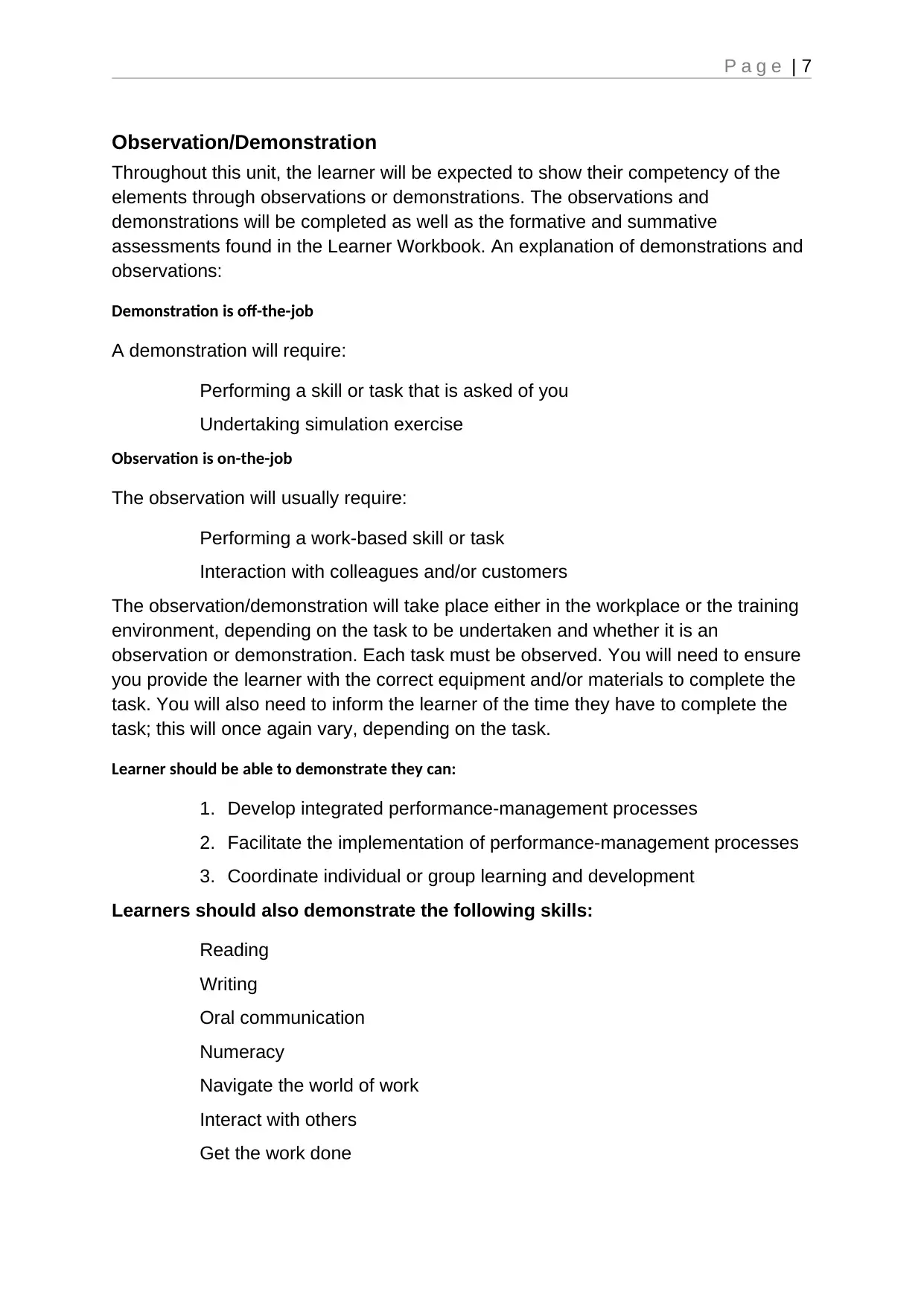
P a g e | 7
Observation/Demonstration
Throughout this unit, the learner will be expected to show their competency of the
elements through observations or demonstrations. The observations and
demonstrations will be completed as well as the formative and summative
assessments found in the Learner Workbook. An explanation of demonstrations and
observations:
Demonstration is off-the-job
A demonstration will require:
Performing a skill or task that is asked of you
Undertaking simulation exercise
Observation is on-the-job
The observation will usually require:
Performing a work-based skill or task
Interaction with colleagues and/or customers
The observation/demonstration will take place either in the workplace or the training
environment, depending on the task to be undertaken and whether it is an
observation or demonstration. Each task must be observed. You will need to ensure
you provide the learner with the correct equipment and/or materials to complete the
task. You will also need to inform the learner of the time they have to complete the
task; this will once again vary, depending on the task.
Learner should be able to demonstrate they can:
1. Develop integrated performance-management processes
2. Facilitate the implementation of performance-management processes
3. Coordinate individual or group learning and development
Learners should also demonstrate the following skills:
Reading
Writing
Oral communication
Numeracy
Navigate the world of work
Interact with others
Get the work done
Observation/Demonstration
Throughout this unit, the learner will be expected to show their competency of the
elements through observations or demonstrations. The observations and
demonstrations will be completed as well as the formative and summative
assessments found in the Learner Workbook. An explanation of demonstrations and
observations:
Demonstration is off-the-job
A demonstration will require:
Performing a skill or task that is asked of you
Undertaking simulation exercise
Observation is on-the-job
The observation will usually require:
Performing a work-based skill or task
Interaction with colleagues and/or customers
The observation/demonstration will take place either in the workplace or the training
environment, depending on the task to be undertaken and whether it is an
observation or demonstration. Each task must be observed. You will need to ensure
you provide the learner with the correct equipment and/or materials to complete the
task. You will also need to inform the learner of the time they have to complete the
task; this will once again vary, depending on the task.
Learner should be able to demonstrate they can:
1. Develop integrated performance-management processes
2. Facilitate the implementation of performance-management processes
3. Coordinate individual or group learning and development
Learners should also demonstrate the following skills:
Reading
Writing
Oral communication
Numeracy
Navigate the world of work
Interact with others
Get the work done
Paraphrase This Document
Need a fresh take? Get an instant paraphrase of this document with our AI Paraphraser
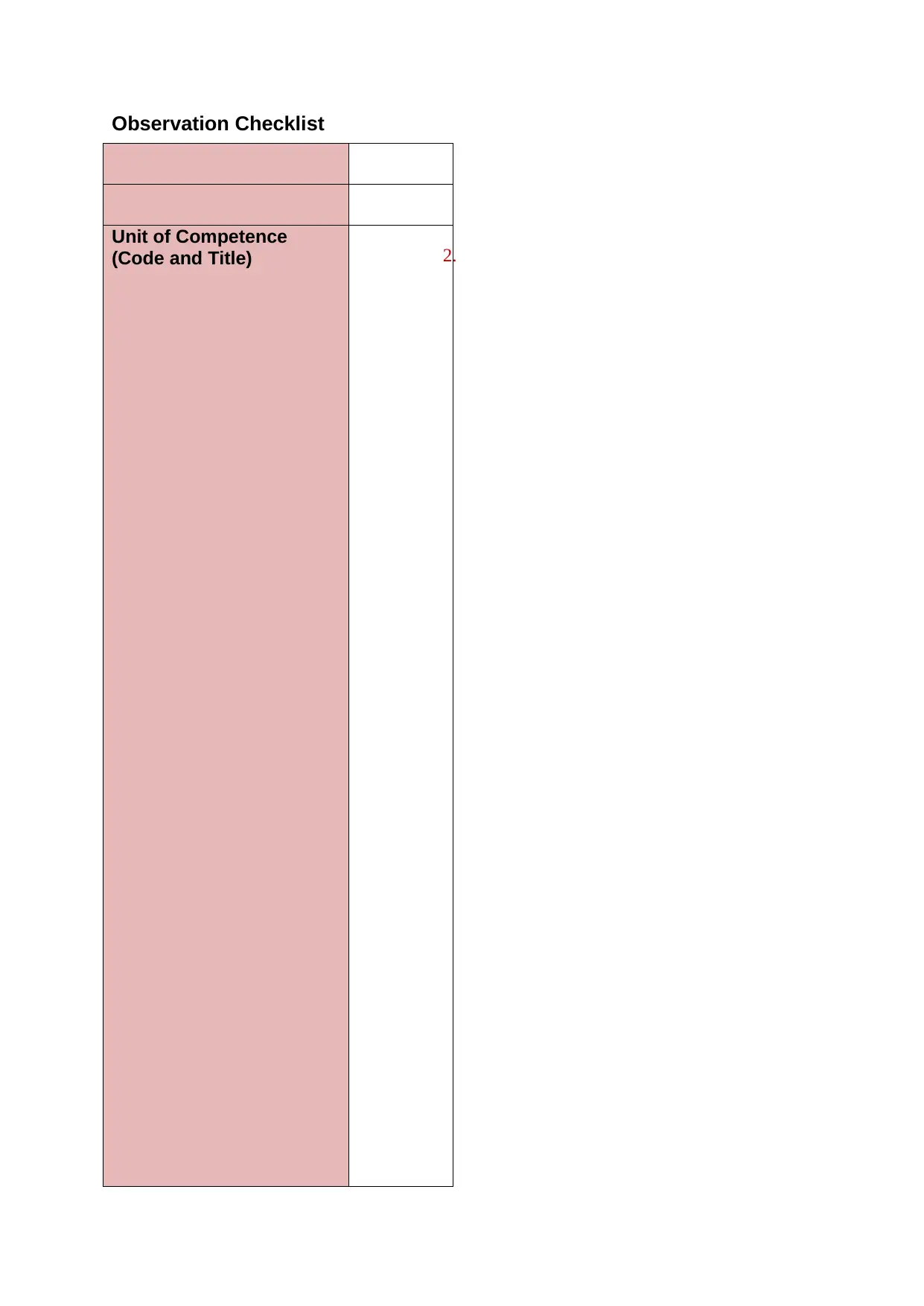
Observation Checklist
Unit of Competence
(Code and Title) 2.
Unit of Competence
(Code and Title) 2.
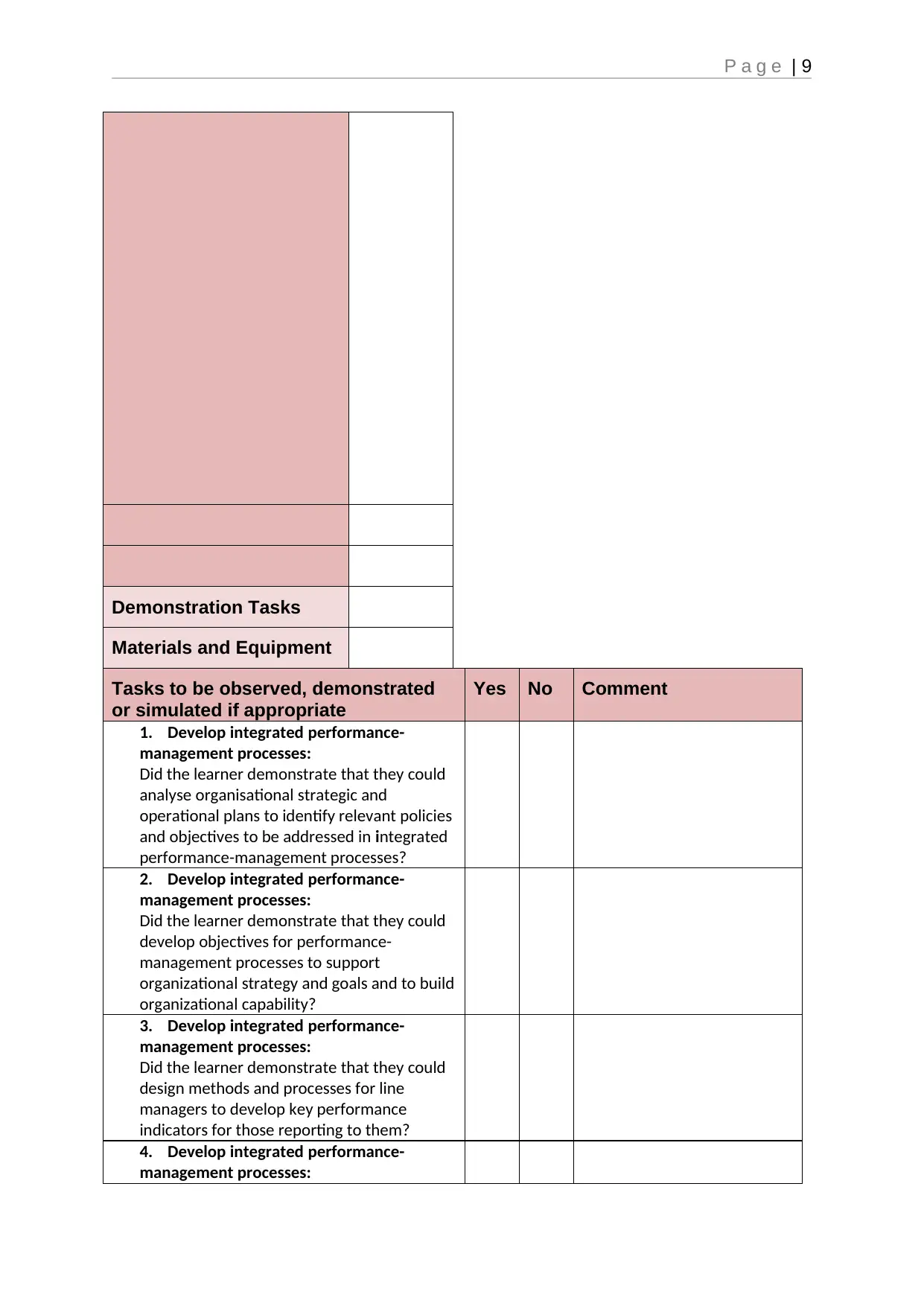
P a g e | 9
Demonstration Tasks
Materials and Equipment
Tasks to be observed, demonstrated
or simulated if appropriate
Yes No Comment
1. Develop integrated performance-
management processes:
Did the learner demonstrate that they could
analyse organisational strategic and
operational plans to identify relevant policies
and objectives to be addressed in integrated
performance-management processes?
2. Develop integrated performance-
management processes:
Did the learner demonstrate that they could
develop objectives for performance-
management processes to support
organizational strategy and goals and to build
organizational capability?
3. Develop integrated performance-
management processes:
Did the learner demonstrate that they could
design methods and processes for line
managers to develop key performance
indicators for those reporting to them?
4. Develop integrated performance-
management processes:
Demonstration Tasks
Materials and Equipment
Tasks to be observed, demonstrated
or simulated if appropriate
Yes No Comment
1. Develop integrated performance-
management processes:
Did the learner demonstrate that they could
analyse organisational strategic and
operational plans to identify relevant policies
and objectives to be addressed in integrated
performance-management processes?
2. Develop integrated performance-
management processes:
Did the learner demonstrate that they could
develop objectives for performance-
management processes to support
organizational strategy and goals and to build
organizational capability?
3. Develop integrated performance-
management processes:
Did the learner demonstrate that they could
design methods and processes for line
managers to develop key performance
indicators for those reporting to them?
4. Develop integrated performance-
management processes:
⊘ This is a preview!⊘
Do you want full access?
Subscribe today to unlock all pages.

Trusted by 1+ million students worldwide
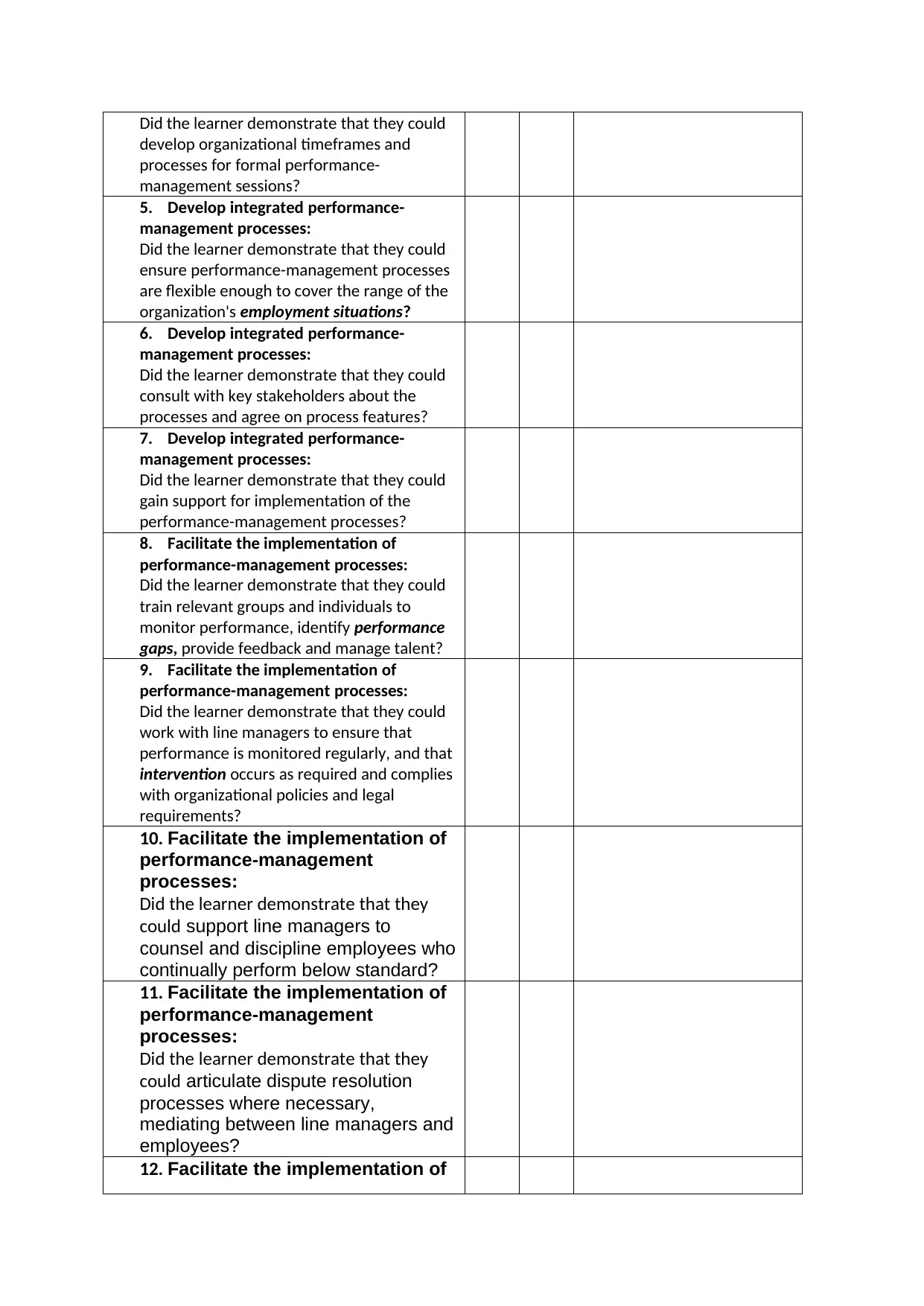
Did the learner demonstrate that they could
develop organizational timeframes and
processes for formal performance-
management sessions?
5. Develop integrated performance-
management processes:
Did the learner demonstrate that they could
ensure performance-management processes
are flexible enough to cover the range of the
organization's employment situations?
6. Develop integrated performance-
management processes:
Did the learner demonstrate that they could
consult with key stakeholders about the
processes and agree on process features?
7. Develop integrated performance-
management processes:
Did the learner demonstrate that they could
gain support for implementation of the
performance-management processes?
8. Facilitate the implementation of
performance-management processes:
Did the learner demonstrate that they could
train relevant groups and individuals to
monitor performance, identify performance
gaps, provide feedback and manage talent?
9. Facilitate the implementation of
performance-management processes:
Did the learner demonstrate that they could
work with line managers to ensure that
performance is monitored regularly, and that
intervention occurs as required and complies
with organizational policies and legal
requirements?
10. Facilitate the implementation of
performance-management
processes:
Did the learner demonstrate that they
could support line managers to
counsel and discipline employees who
continually perform below standard?
11. Facilitate the implementation of
performance-management
processes:
Did the learner demonstrate that they
could articulate dispute resolution
processes where necessary,
mediating between line managers and
employees?
12. Facilitate the implementation of
develop organizational timeframes and
processes for formal performance-
management sessions?
5. Develop integrated performance-
management processes:
Did the learner demonstrate that they could
ensure performance-management processes
are flexible enough to cover the range of the
organization's employment situations?
6. Develop integrated performance-
management processes:
Did the learner demonstrate that they could
consult with key stakeholders about the
processes and agree on process features?
7. Develop integrated performance-
management processes:
Did the learner demonstrate that they could
gain support for implementation of the
performance-management processes?
8. Facilitate the implementation of
performance-management processes:
Did the learner demonstrate that they could
train relevant groups and individuals to
monitor performance, identify performance
gaps, provide feedback and manage talent?
9. Facilitate the implementation of
performance-management processes:
Did the learner demonstrate that they could
work with line managers to ensure that
performance is monitored regularly, and that
intervention occurs as required and complies
with organizational policies and legal
requirements?
10. Facilitate the implementation of
performance-management
processes:
Did the learner demonstrate that they
could support line managers to
counsel and discipline employees who
continually perform below standard?
11. Facilitate the implementation of
performance-management
processes:
Did the learner demonstrate that they
could articulate dispute resolution
processes where necessary,
mediating between line managers and
employees?
12. Facilitate the implementation of
Paraphrase This Document
Need a fresh take? Get an instant paraphrase of this document with our AI Paraphraser
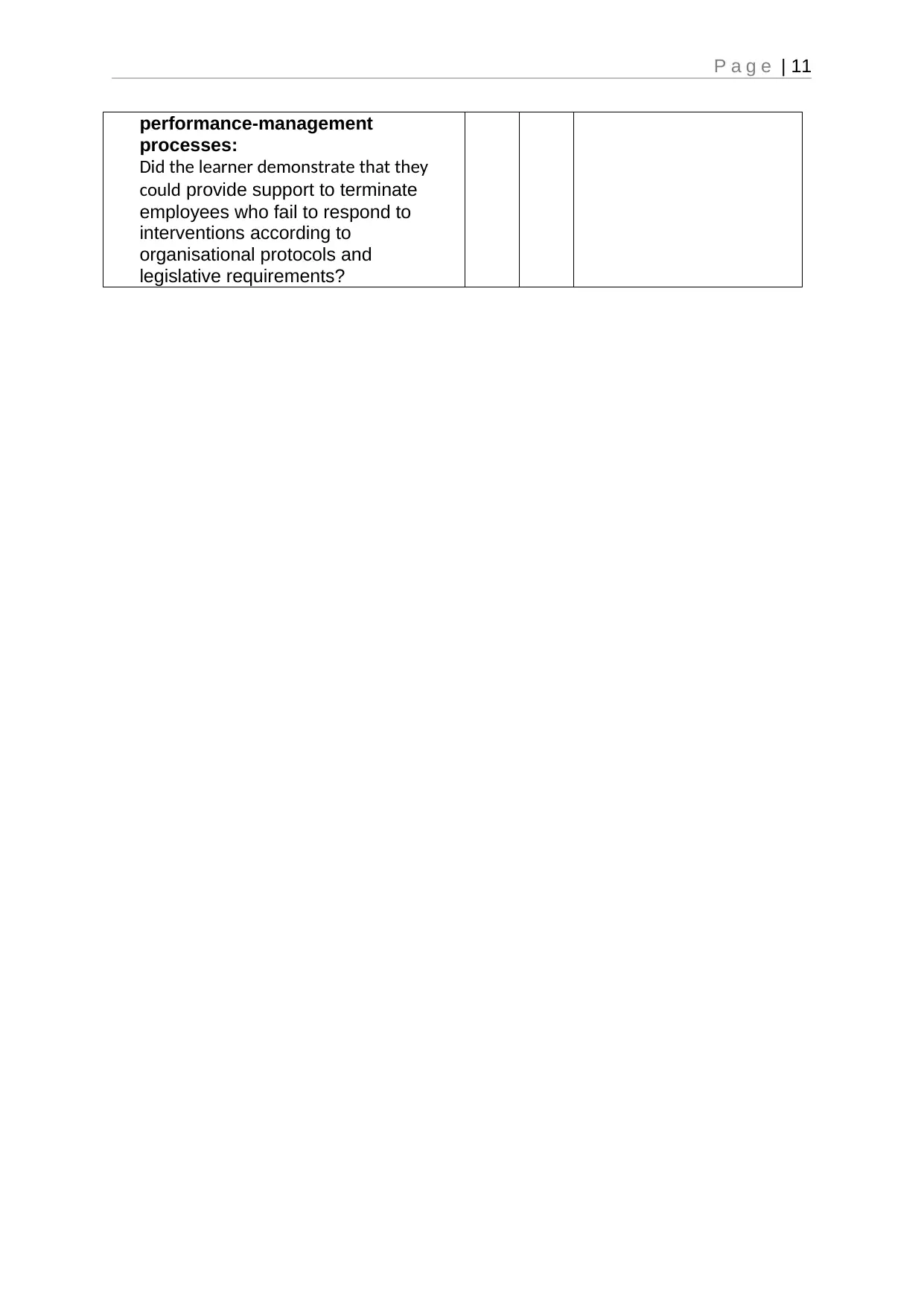
P a g e | 11
performance-management
processes:
Did the learner demonstrate that they
could provide support to terminate
employees who fail to respond to
interventions according to
organisational protocols and
legislative requirements?
performance-management
processes:
Did the learner demonstrate that they
could provide support to terminate
employees who fail to respond to
interventions according to
organisational protocols and
legislative requirements?
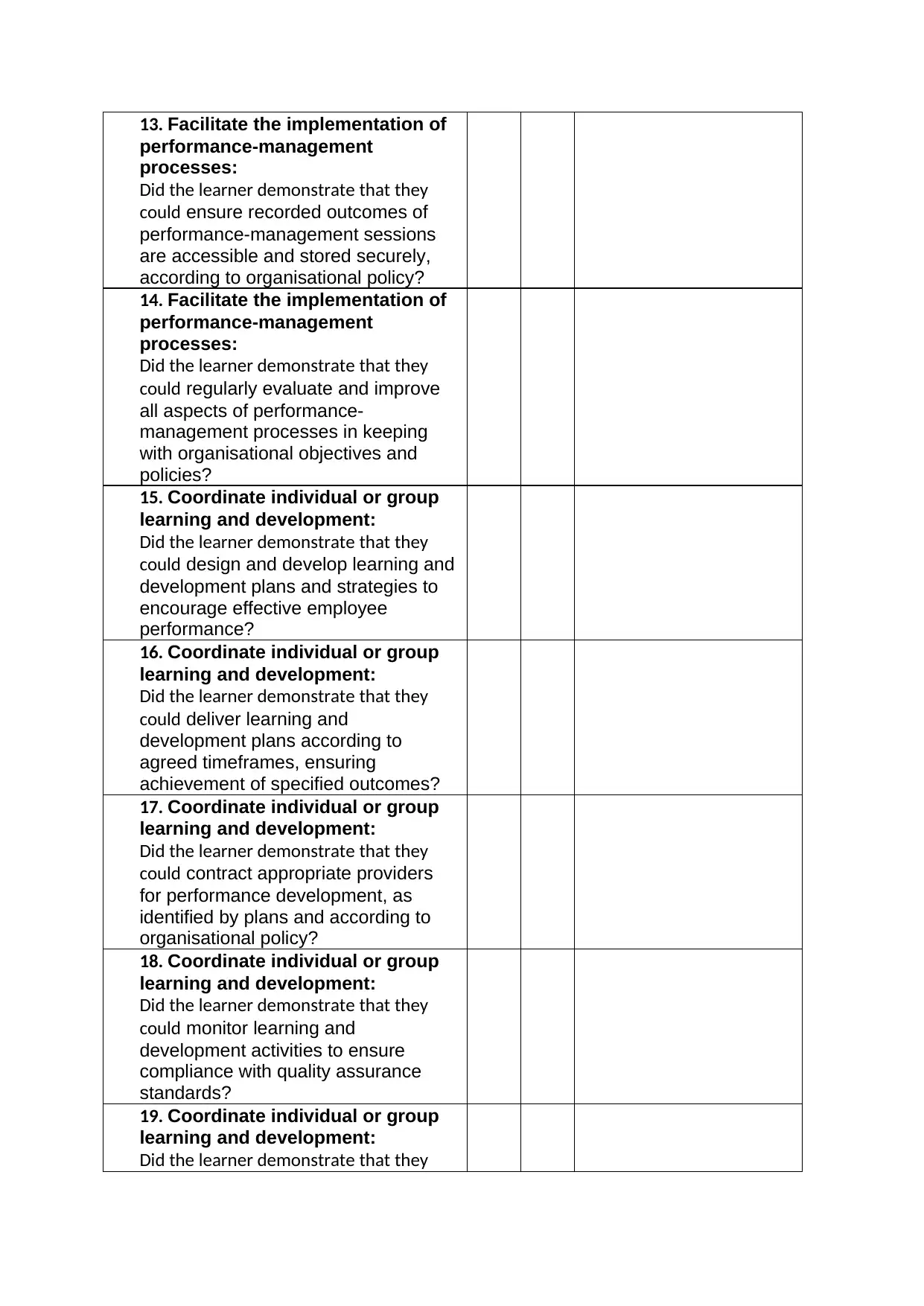
13. Facilitate the implementation of
performance-management
processes:
Did the learner demonstrate that they
could ensure recorded outcomes of
performance-management sessions
are accessible and stored securely,
according to organisational policy?
14. Facilitate the implementation of
performance-management
processes:
Did the learner demonstrate that they
could regularly evaluate and improve
all aspects of performance-
management processes in keeping
with organisational objectives and
policies?
15. Coordinate individual or group
learning and development:
Did the learner demonstrate that they
could design and develop learning and
development plans and strategies to
encourage effective employee
performance?
16. Coordinate individual or group
learning and development:
Did the learner demonstrate that they
could deliver learning and
development plans according to
agreed timeframes, ensuring
achievement of specified outcomes?
17. Coordinate individual or group
learning and development:
Did the learner demonstrate that they
could contract appropriate providers
for performance development, as
identified by plans and according to
organisational policy?
18. Coordinate individual or group
learning and development:
Did the learner demonstrate that they
could monitor learning and
development activities to ensure
compliance with quality assurance
standards?
19. Coordinate individual or group
learning and development:
Did the learner demonstrate that they
performance-management
processes:
Did the learner demonstrate that they
could ensure recorded outcomes of
performance-management sessions
are accessible and stored securely,
according to organisational policy?
14. Facilitate the implementation of
performance-management
processes:
Did the learner demonstrate that they
could regularly evaluate and improve
all aspects of performance-
management processes in keeping
with organisational objectives and
policies?
15. Coordinate individual or group
learning and development:
Did the learner demonstrate that they
could design and develop learning and
development plans and strategies to
encourage effective employee
performance?
16. Coordinate individual or group
learning and development:
Did the learner demonstrate that they
could deliver learning and
development plans according to
agreed timeframes, ensuring
achievement of specified outcomes?
17. Coordinate individual or group
learning and development:
Did the learner demonstrate that they
could contract appropriate providers
for performance development, as
identified by plans and according to
organisational policy?
18. Coordinate individual or group
learning and development:
Did the learner demonstrate that they
could monitor learning and
development activities to ensure
compliance with quality assurance
standards?
19. Coordinate individual or group
learning and development:
Did the learner demonstrate that they
⊘ This is a preview!⊘
Do you want full access?
Subscribe today to unlock all pages.

Trusted by 1+ million students worldwide
1 out of 48
Related Documents
Your All-in-One AI-Powered Toolkit for Academic Success.
+13062052269
info@desklib.com
Available 24*7 on WhatsApp / Email
![[object Object]](/_next/static/media/star-bottom.7253800d.svg)
Unlock your academic potential
Copyright © 2020–2025 A2Z Services. All Rights Reserved. Developed and managed by ZUCOL.





